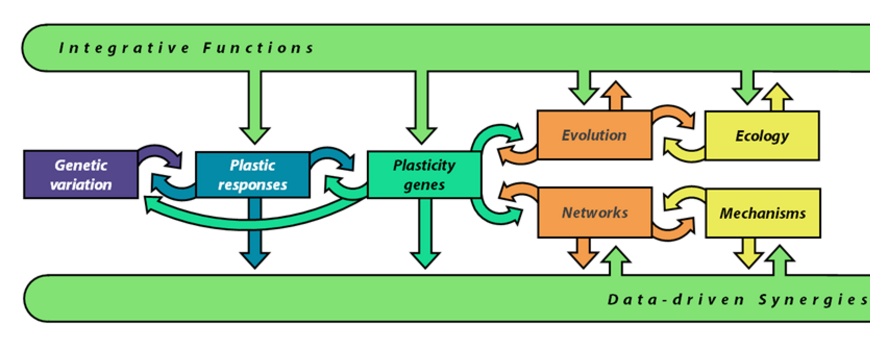Detailed summary of the research programme
The ability of a given genotype to generate different phenotypes in different environments is termed phenotypic plasticity (PP). PP is a universal feature of life, and understanding its molecular basis and evolution is a fundamental goal in biology, with major implications for predicting plant responses to a changing climate and for accelerating plant breeding tailored to specific environments.
Genotypes can differ in their plastic responses to the same environmental cue, and natural populations often harbor genetic variation in the extent of plasticity on which selection can act. Thus, plasticity of a focal trait to an environmental cue is itself a heritable trait. That said, PP is not unlimited, but is associated with costs and constraints. One important source of such constraints are genetic correlations between plastic responses of different traits. The magnitude and shape of plastic responses can be described by the reaction norm that relates the trait values of a given genotype to the values of the environmental cue. Previous work has demonstrated ample variation in PP, including variation in reaction-norm shapes. The molecular mechanisms underlying plasticity to particular cues have been elucidated in detail for a number of traits in reference genotypes. However, we still know very little about the genetic and molecular basis of natural variation in PP, its evolution and the factors that constrain it. In other words, what makes different genotypes respond differently to the same environmental cue?
To address this overarching question, our CRC will tackle the following four common questions across the individual projects:
- What is the genetic and molecular basis of variation in phenotypic plasticity of key traits to environmental cues in natural populations?
- How do the genes that influence the reaction norm of a trait act mechanistically, and to what extent are the molecular mechanisms shared across taxa?
- Are there genetic correlations between the extents of phenotypic plasticity for different focal traits, and if so, what is their molecular basis?
- Which type of natural selection acts on phenotypic plasticity of a focal trait, and is there evidence for recent positive selection on plasticity?
Plant growth and fitness respond to two major types of environmental factors: conditions and resources. Conditions include biophysical features of a given habitat, such as temperature, while resources are substances or objects, e.g. nutrients, water or space, that plants consume and for which they compete, altering their availability. The different spatiotemporal dynamics of conditions and resources raise the question of whether plants use the same PP strategies when responding to variation in both types of factors. Therefore, we use the distinction between conditions and resources to structure our consortium. Project area A will study plasticity to conditions, while projects in area B will investigate plasticity to resources.
To achieve the above goals, our consortium will integrate genetics, cell and developmental biology, physiology, evolutionary biology, ecology, computational biology and mathematical modeling. As a result, we will obtain a step-change in our understanding of phenotypic plasticity as an evolving trait of critical importance to the fate of plant populations in the face of environmental change.
A conceptual summary of our CRC research program is shown in Figure 1.
Figure 1: Graphical summary of our research programme.
Over the course of the three funding periods, work in the scientific projects will exploit genetic variation in phenotypic plasticity (PP) and reaction norms to identify the underlying plasticity genes. This knowledge will in turn be used to address both the basis of PP in molecular networks and mechanisms as well as its evolution and ecological relevance (boxes in centre). Integrative functions provided by projects A8 and particularly Z2 (green U-shape) will ensure synergies and answers to higher-level questions about phenotypic plasticity.

